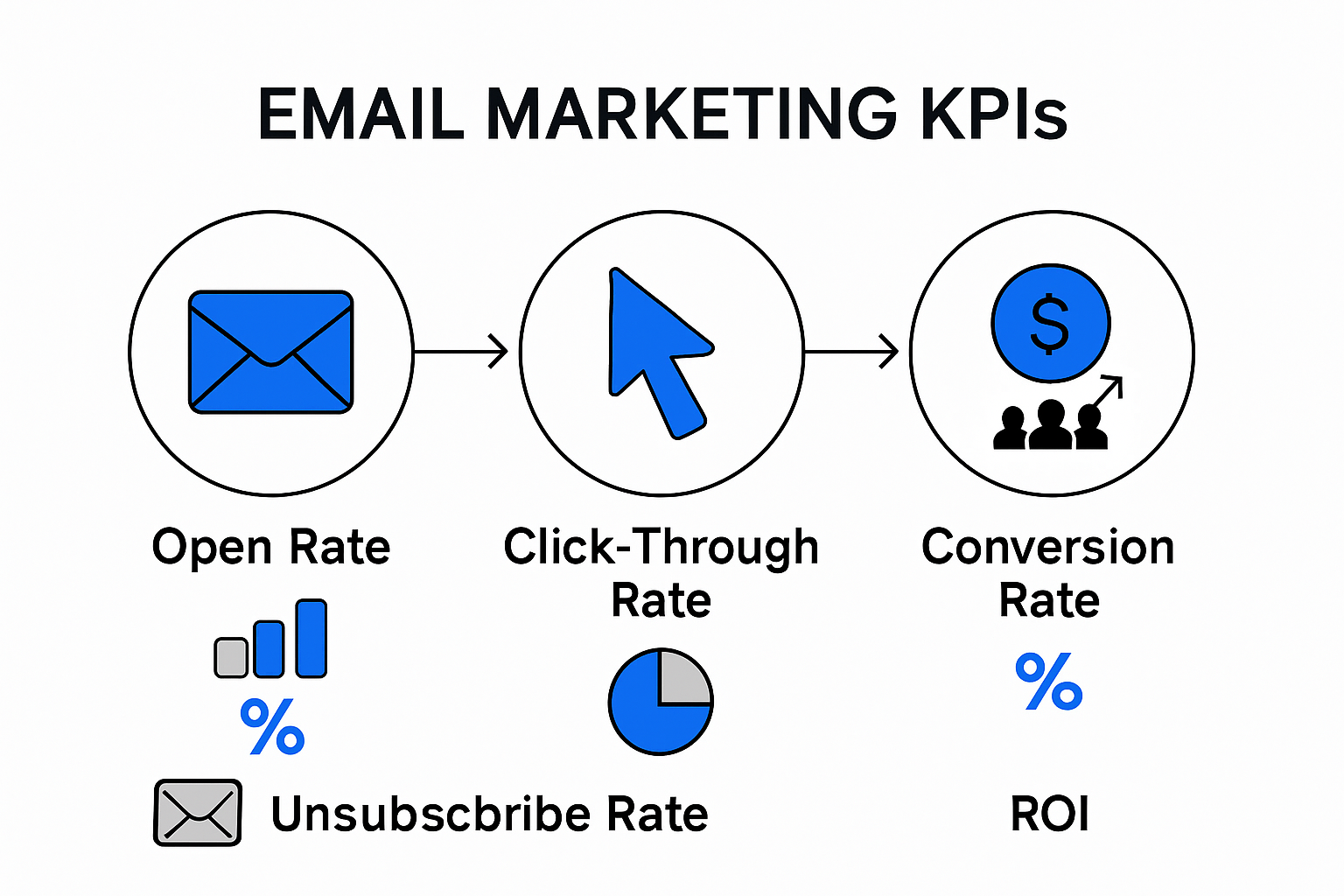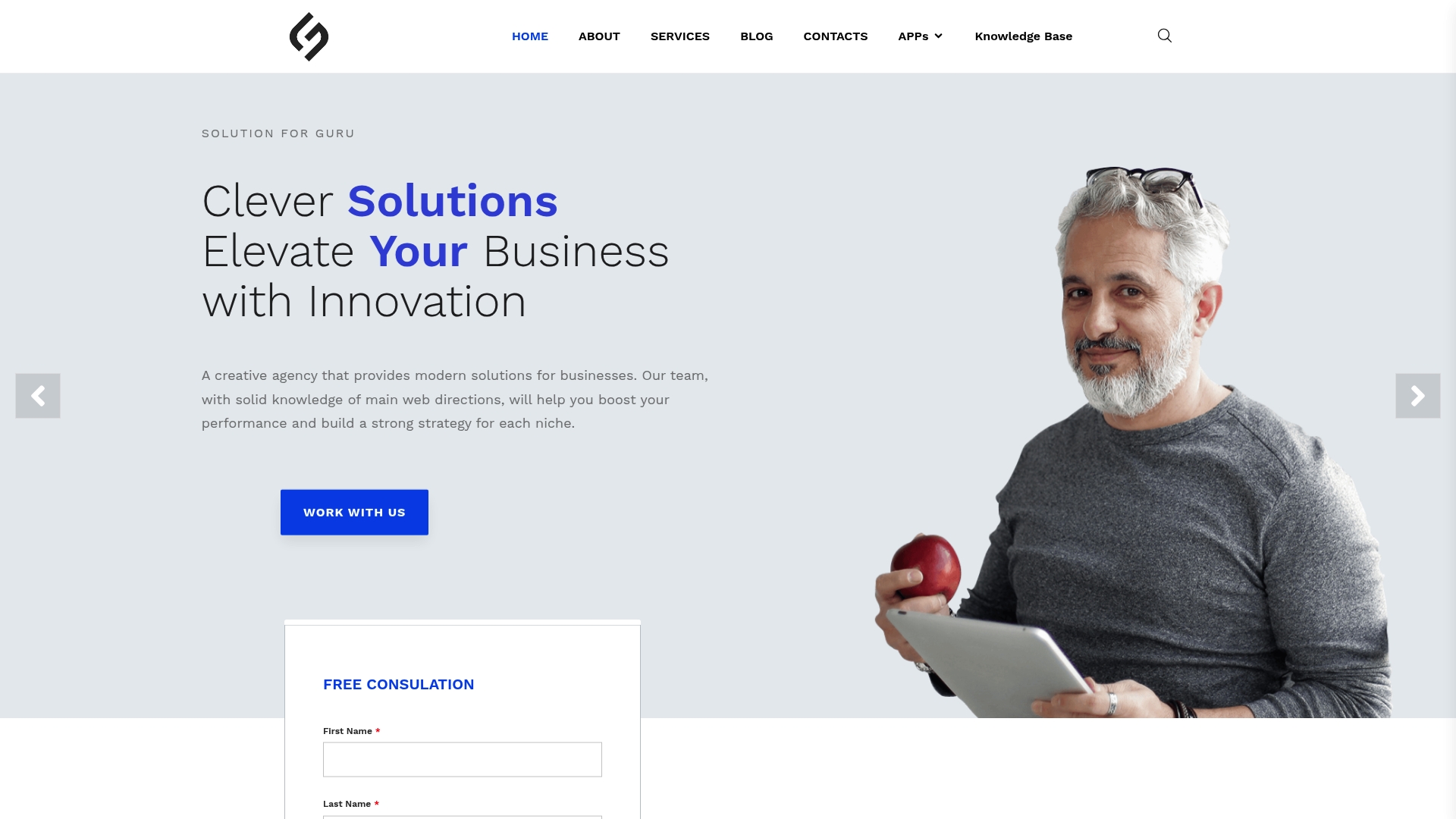Email Marketing Essentials: Strategies for Business Growth

Email marketing still drives results that most channels can only dream about and the proof is staggering. The average return on investment is a jaw-dropping $42 for every $1 spent. Most people expect email blasts to be old news or too generic to matter. Turns out, the secret weapon for serious business growth is not sending more emails, but getting laser-focused with ethics, personalization, and data you already have. Ready to find out why this low-key tactic is fueling some of the biggest successes in digital marketing?
Table of Contents
- Key Elements Of Effective Email Campaigns
- Building And Growing Your Email List
- Personalization And Automation Best Practices
- Measuring Success And Optimizing Results
Quick Summary
| Takeaway | Explanation |
|---|---|
| Craft personalized subject lines | Personalized subject lines can boost open rates significantly, making them essential for engagement. |
| Segment your email list | Targeted segmentation leads to more relevant messaging, enhancing the connection with your audience. |
| Utilize A/B testing for improvement | Regularly test different email elements to optimize performance and adapt to audience preferences effectively. |
| Build your email list ethically | Gaining explicit consent fosters trust and leads to higher engagement rates with your audience. |
| Focus on measurable KPIs | Tracking key performance indicators helps understand how well your campaigns drive desired actions. |
Key Elements of Effective Email Campaigns
Email marketing continues to be a powerful strategy for businesses seeking direct communication with their audience. Creating successful email campaigns requires a strategic approach that combines creativity, data-driven insights, and precise execution.
Crafting Compelling Content and Design
The heart of any effective email campaign lies in its content and visual presentation. According to MIT’s communication guidelines, tailoring messages to specific audience needs is crucial. This means developing content that speaks directly to the recipient’s interests, challenges, and preferences.
Successful email design involves several critical components. The subject line serves as the first point of contact, acting as a gateway to engagement. Subject Line Strategy becomes paramount – it must be concise, intriguing, and value-driven. Research suggests that personalized subject lines can increase open rates by up to 26%.
Visual design plays an equally important role. Emails should be clean, responsive, and easy to read across different devices. Use a balanced layout with clear hierarchy, strategic use of white space, and visually appealing graphics that support your message. Color psychology and consistent branding can significantly impact how recipients perceive your communication.
Targeting and Personalization Techniques
Digital.gov recommends a targeted approach to email marketing. Segmentation is no longer optional but a necessity. Breaking down your email list into specific groups based on demographics, behavior, purchase history, or engagement levels allows for more precise messaging.
Personalization goes beyond simply inserting a recipient’s name. Advanced personalization involves delivering content that feels individually crafted. This might include product recommendations based on past purchases, content tailored to specific user interactions, or timely offers that align with the recipient’s demonstrated interests.
Measuring and Optimizing Campaign Performance
Penn State Extension emphasizes the importance of developing clear objectives for each email campaign. Key performance indicators (KPIs) such as open rates, click-through rates, conversion rates, and unsubscribe rates provide critical insights into campaign effectiveness.
A/B testing emerges as a powerful tool for continuous improvement. By testing different elements – from subject lines and send times to content structure and call-to-action placement – marketers can incrementally enhance their email marketing strategy. Regular analysis and adaptation ensure that email campaigns remain dynamic and responsive to changing audience preferences.
Successful email marketing is not about sending more emails, but about sending the right emails to the right people at the right time. By focusing on compelling content, strategic targeting, and data-driven optimization, businesses can transform their email campaigns from simple communications to powerful marketing instruments.
Building and Growing Your Email List
Building a robust and engaged email list is fundamental to successful email marketing strategies. Unlike purchased lists, an organically grown email database represents genuine connections with potential customers who are truly interested in your brand and offerings.
Ethical List Building Strategies
The U.S. Small Business Administration emphasizes the critical importance of obtaining explicit permission before adding individuals to your email list. This approach not only ensures legal compliance but also builds trust with your audience. Transparent consent mechanisms protect your brand’s reputation and improve overall email engagement rates.
Opt-in Techniques represent the cornerstone of ethical list building. Implement multiple touchpoints where potential subscribers can voluntarily join your mailing list. Website pop-ups, landing pages, social media sign-up forms, and event registrations provide excellent opportunities for capturing interested contacts. Each sign-up point should clearly communicate the value proposition – what subscribers can expect to receive and how frequently.
The following table summarizes ethical and strategic list building techniques described in the article, along with their purposes. Use this as a checklist to ensure your email list growth follows best practices.
| Method | Purpose |
|---|---|
| Explicit permission/opt-in | Obtain clear consent & build audience trust |
| Website pop-ups & landing pages | Capture interested visitors for your mailing list |
| Event & webinar registrations | Grow the list with engaged participants |
| Social media sign-up forms | Leverage platforms for broader, ethical acquisition |
| Content incentives (e.g., guides) | Offer value in exchange for contact information |
| Referral programs | Encourage existing subscribers to invite others |
According to Mississippi State University Extension Service, email marketing offers an impressive average return of $42 for every $1 spent. This substantial potential return underscores the importance of developing a high-quality email list that genuinely connects with your target audience.
Strategic List Acquisition Methods
The Rhode Island Small Business Development Center strongly advises against purchasing email lists. Such practices often lead to low engagement rates, potential legal complications, and can damage your sender reputation. Instead, focus on organic growth strategies that attract genuinely interested subscribers.
Consider implementing these strategic acquisition methods:
- Content Incentives: Create downloadable resources like whitepapers, guides, or exclusive research reports that users can access by providing their email address.
- Webinar and Event Registrations: Host online or in-person events that require email registration.
- Social Media Integration: Use social platforms to promote email list sign-ups with clear value propositions.
- Referral Programs: Encourage existing subscribers to refer friends and colleagues by offering mutual benefits.
Maintaining List Quality and Engagement
Growing your email list is not just about quantity but maintaining high-quality, engaged subscribers. Regularly clean your list by removing inactive subscribers and implement re-engagement campaigns for contacts showing diminishing interaction.
Implement segmentation strategies that allow you to categorize subscribers based on their interests, behaviors, and engagement levels. This approach enables more personalized and targeted communication, which ultimately improves list performance and subscriber retention.
Effective email list building is a continuous process of attracting, engaging, and nurturing potential subscribers. By prioritizing permission-based strategies, providing genuine value, and maintaining list hygiene, businesses can develop a powerful marketing asset that drives meaningful connections and business growth.
Personalization and Automation Best Practices
Personalization and automation represent powerful strategies that transform email marketing from generic communications to targeted, intelligent interactions. By leveraging data-driven approaches, businesses can create more meaningful connections with their audience while increasing operational efficiency.
Advanced Segmentation Techniques
The University of Colorado emphasizes the critical importance of precise audience segmentation. Rather than sending blanket communications, successful email strategies focus on delivering highly relevant content to the smallest possible group. This approach ensures that each recipient receives information specifically tailored to their interests, behaviors, and engagement history.
Data-Driven Segmentation involves analyzing multiple dimensions of subscriber information. These might include demographic details, past purchase behavior, interaction history with previous emails, website browsing patterns, and specific engagement metrics. By creating granular segments, businesses can craft messages that feel personally curated rather than mass-produced.
Effective segmentation goes beyond basic demographic categorization. Advanced marketers develop complex personas that capture nuanced characteristics of their audience. This might involve creating segments based on lifecycle stage, purchasing intent, content preferences, or even predictive behavior models.
Automation Strategies for Enhanced Engagement
Becker College’s communication research demonstrates the remarkable potential of automated, personalized communications. Their implementation of an automated system resulted in an impressive 51% open rate and a 25% click-through rate, highlighting the power of strategic email automation.
Automation allows businesses to create sophisticated communication workflows that respond dynamically to user actions. Key automation strategies include:
- Trigger-Based Emails: Automatically sending communications based on specific user actions like website visits, abandoned cart, or milestone achievements.
- Behavioral Segmentation: Dynamically adjusting email content based on real-time user interactions and preferences.
- Lifecycle Marketing: Creating targeted email sequences that align with different stages of customer journey.
Implementing Intelligent Personalization
True personalization extends far beyond inserting a recipient’s name. Modern email personalization involves creating contextually relevant experiences that feel individually crafted. This means leveraging machine learning and advanced analytics to predict and address individual user needs.
Intelligent personalization techniques include:
- Recommending products based on past purchase history
- Sending time-sensitive offers aligned with individual preferences
- Adapting email content design and messaging to match user interaction patterns
- Creating dynamic content blocks that change based on recipient characteristics
Successful personalization requires a robust data infrastructure and a commitment to continuous learning. By treating each email as an opportunity for meaningful communication, businesses can transform their email marketing from a broadcast medium to a sophisticated, responsive engagement platform.
The future of email marketing lies in creating experiences that feel simultaneously personal and effortless. Through strategic segmentation, intelligent automation, and nuanced personalization, businesses can build deeper, more authentic connections with their audience.

Measuring Success and Optimizing Results
Measuring and optimizing email marketing performance requires a strategic approach that goes beyond surface-level metrics. Successful businesses understand that continuous improvement depends on comprehensive analysis and data-driven decision making.
Key Performance Indicators for Email Marketing
The University of Colorado provides critical insights into selecting meaningful performance metrics. While traditional open rates have become less reliable due to privacy enhancements, several robust indicators can provide deep insights into email campaign effectiveness.
Performance Metrics that deliver meaningful insights include:

- Click-through rates (CTR)
- Conversion rates
- Link engagement
- Unsubscribe rates
- List growth rate
- Revenue per email
These metrics offer a comprehensive view of how recipients interact with your email content. By tracking these indicators, businesses can understand not just how many people open emails, but how effectively those emails drive desired actions.
Here’s a summary table organizing the key email marketing performance metrics discussed in this section. This table helps readers quickly understand which KPIs to monitor and what each metric represents.
| Metric | What It Measures |
|---|---|
| Click-through rate (CTR) | Percentage of recipients clicking links in the email |
| Conversion rate | Percentage of recipients completing a desired action |
| Link engagement | Interaction level with specific content links |
| Unsubscribe rate | Percentage of recipients opting out from future emails |
| List growth rate | Speed at which your email list is expanding |
| Revenue per email | Amount of revenue generated for each email sent |
Advanced Analytics and Optimization Strategies
Penn State Extension recommends a systematic approach to email marketing optimization. This involves continuous testing, measurement, and strategic adaptation of email marketing elements.
A/B testing emerges as a powerful technique for incremental improvement. By systematically testing different elements of email campaigns, businesses can identify precisely what resonates with their audience. Key areas for A/B testing include:
- Subject line variations
- Email content formatting
- Call-to-action placement and design
- Send times and frequency
- Visual design elements
Advanced analytics platforms now offer sophisticated tracking capabilities that go beyond basic metrics. These tools can provide granular insights into user behavior, including time spent reading, scroll depth, and cross-platform engagement.
Creating a Continuous Improvement Framework
Developing a robust optimization framework requires more than just collecting data. It demands a structured approach to interpreting and acting on insights. This means establishing regular review cycles, creating clear benchmarks, and maintaining flexibility to pivot strategies based on emerging trends.
Effective optimization involves:
- Setting clear, measurable goals for each email campaign
- Developing baseline performance metrics
- Implementing systematic testing protocols
- Creating feedback loops for continuous learning
- Staying updated with emerging email marketing technologies
Successful email marketing is not a static process but a dynamic, evolving strategy. By embracing data-driven optimization, businesses can transform their email campaigns from static communications to responsive, high-performing marketing channels.
The most successful email marketers view each campaign as an opportunity to learn, adapt, and improve. Through meticulous measurement, strategic testing, and a commitment to ongoing refinement, businesses can unlock the full potential of their email marketing efforts.
Frequently Asked Questions
What are the key elements of an effective email marketing campaign?
The key elements include compelling content and design, targeted audience segmentation, and continuous performance measurement and optimization.
How can I build my email list ethically?
Building your email list ethically involves obtaining explicit permission from subscribers, using opt-in strategies, and providing clear value propositions for why they should join your list.
What are some best practices for email personalization?
Best practices for email personalization include advanced segmentation based on user behavior, recommending products based on past purchases, and utilizing dynamic content that adapts to individual recipient characteristics.
How do I measure the success of my email marketing campaigns?
You can measure success by tracking key performance indicators (KPIs) such as open rates, click-through rates, conversion rates, and unsubscribe rates to gain insights into how effectively your campaigns drive engagement and desired actions.
Ready to Transform Your Email Strategy Into Real Growth?
Are you struggling to turn email campaigns into tangible business results? You are not alone. Many companies face challenges with ethical list building, weak personalization, and missing the mark on segmentation. If you want to send the right messages to the right people at the right time, a partner that understands both technology and digital marketing is crucial. Solution4Guru.com combines robust digital marketing expertise with advanced UI/UX and automation to help you unlock the full value of your email investments.

Whether you need sharper campaign strategy, tools to maintain list quality, or custom automation to streamline engagement, our team designs solutions around your biggest obstacles. Success starts with a free consultation and tailored recommendations designed for your unique goals. Visit Solution4Guru.com and take the first step forward now. Your optimized email marketing engine is just one click away.



